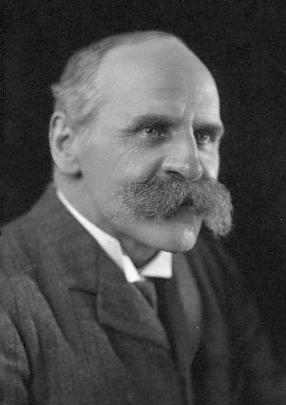
John Scott Haldane
John Scott Haldane CH FRS[1] (/ˈhɔːldeɪn/; 2 May 1860 – 14/15 March 1936) was a British physician physiologist and philosopher famous for intrepid self-experimentation which led to many important discoveries about the human body and the nature of gases.[2] He also experimented on his son, the celebrated and polymathic biologist J. B. S. Haldane, even when he was quite young.[3] Haldane locked himself in sealed chambers breathing potentially lethal cocktails of gases while recording their effect on his mind and body.[4]
For another British physiologist, see John Burdon Sanderson Haldane.
John Scott HaldaneFRS
2 May 1860
14 March 1936 (aged 75)
Louisa Kathleen Coutts Trotter
Fellow of the Royal Society, member of the Royal College of Physicians and of the Royal Society of Medicine; many honorary degrees
Physiology, medicine
Haldane visited the scenes of many mining disasters and investigated their causes.[2][5] When the Germans used poison gas in World War I, Haldane went to the front at the request of Lord Kitchener and attempted to identify the gases being used. One outcome of this was his invention of a respirator, known as the black veil.[2][6][4]
Haldane's investigations into decompression sickness resulted in the concept of staged decompression, and the first reasonably reliable decompression tables, and his mathematical model is still used in highly modified forms for computing decompression schedules.[2][4]
Background and family[edit]
Haldane was born in Edinburgh to Robert Haldane, whose father was Scottish evangelist James Alexander Haldane, and Mary Elizabeth Burdon-Sanderson, daughter of Richard Burdon-Sanderson and the granddaughter of Sir Thomas Burdon. His maternal uncle was the physiologist John Scott Burdon-Sanderson. He was the brother of Elizabeth Haldane, William Haldane and Richard Haldane, 1st Viscount Haldane.[1]
Education[edit]
Haldane attended Edinburgh Academy, Edinburgh University and the Friedrich Schiller University of Jena. He graduated in medicine from Edinburgh University Medical School in 1884, after which he was a Demonstrator at University College, Dundee. From 1907 to 1913 he was a Reader in Physiology at Oxford University where his uncle, John Burdon-Sanderson, was Waynflete Professor of Physiology.[4]
On 12 December 1891 he married Louisa Kathleen Coutts Trotter (1863–1961),[7] daughter of Coutts Trotter FRGS and Harriet Augusta Keatinge.[8] They had two children: the scientist J. B. S. Haldane and the author Naomi Mitchison. His nephew was the New Zealand doctor and public health administrator Robert Haldane Makgill.[9]
Haldane also published his philosophical ideas about the true significance of biology.[4]
Career[edit]
Haldane was Gifford Lecturer in the University of Glasgow, Fellow of New College, Oxford, from October 1901,[10] and Honorary Professor of the University of Birmingham. Haldane received numerous honorary degrees. He was also President of the English Institution of Mining Engineers, a Member of the Order of the Companions of Honour, a Fellow of the Royal Society,[11] a member of the Royal College of Physicians and of the Royal Society of Medicine.[12]
Haldane became a Fellow of the Royal Society in 1897, was a Royal Medallist of the Society in 1916, was appointed Member of the Order of the Companions of Honour in 1928 for work on industrial disease, and was a Copley Medallist in 1934.[4]
Death[edit]
Haldane died in Oxford at midnight on the night of 14 March/15 March 1936 of pneumonia.[4] He had just returned from a trip he had undertaken to investigate cases of heat stroke in the oil refineries in Persia.[12][13]
Sir Henry Newbolt wrote a poem called "For J. S. Haldane", published in his anthology A Perpetual Memory and other Poems in 1939.[14]
Accomplishments[edit]
Respiration and anaesthesia[edit]
Haldane was an international authority on ether and respiration and the inventor of the Black Veil Respirator, an early gas mask, during World War I.[2][15]
He was also an authority on the effects of pulmonary diseases, such as silicosis caused by inhaling silica dust. After being forced out of combatting poison gases in World War I, through alleged German sympathies, he shifted into working with victims of gas warfare and developed oxygen treatment including the oxygen tent.[16][17]
Haldane helped determine the regulation of breathing, and discovered the Haldane effect in haemoglobin: Deoxygenated haemoglobin has a greater affinity for carbon dioxide than oxygenated haemoglobin, so the release of oxygen from the capillaries to the tissues facilitates the removal of carbon dioxide in those capillaries, and in the lung capillaries the high oxygenation of the blood promotes the release of carbon dioxide to the plasma, which allows it to diffuse into the alveolar gas.[4]
Haldane was the founder of The Journal of Hygiene.[12]